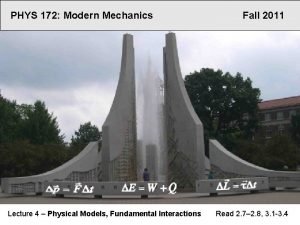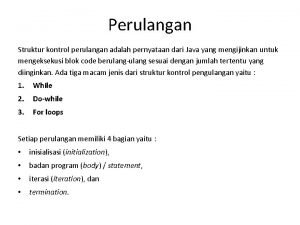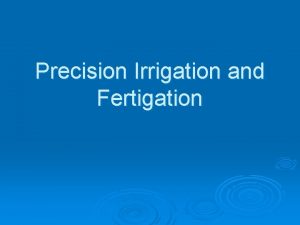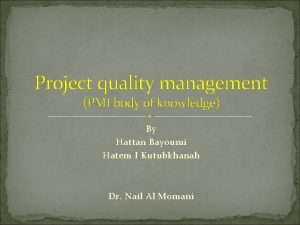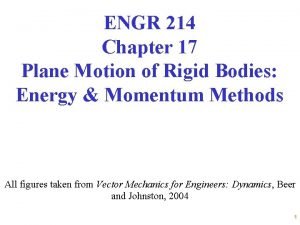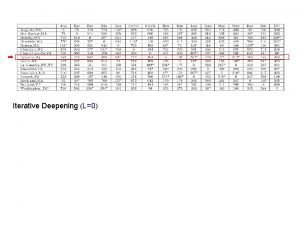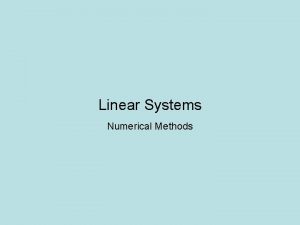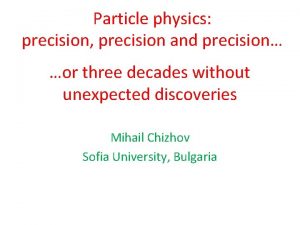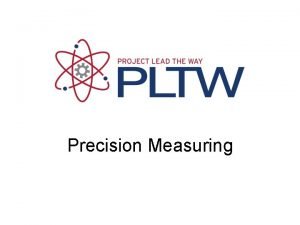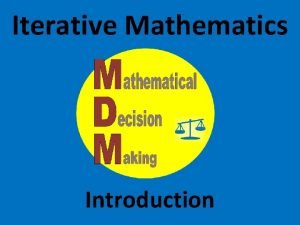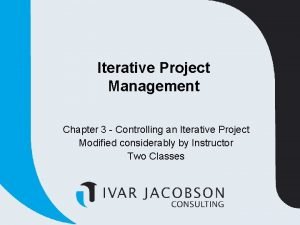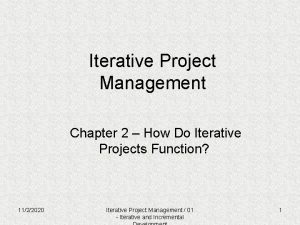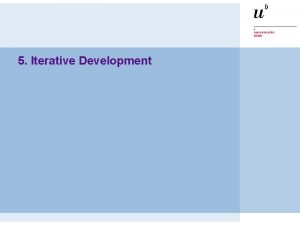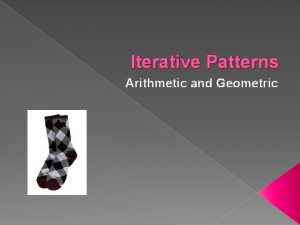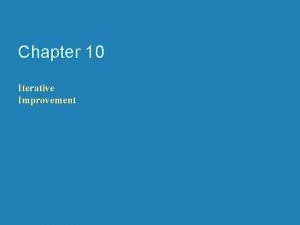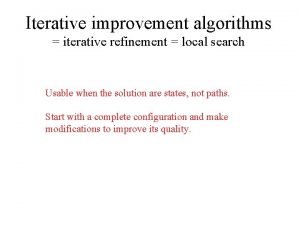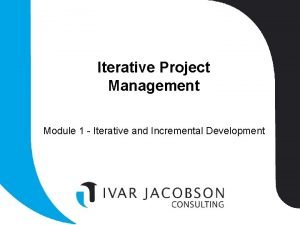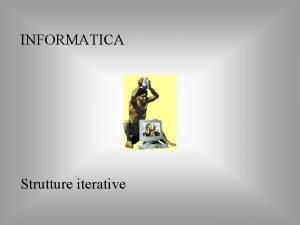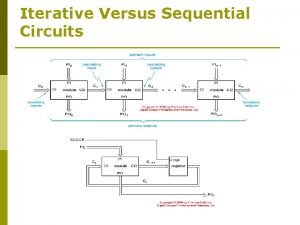Iterative Methods for Precision Motion Control with Application



























































- Slides: 59

Iterative Methods for Precision Motion Control with Application to a Wafer Scanner System Hoday Stearns Advisor: Professor Masayoshi Tomizuka Ph. D Seminar Presentation 2011 -05 -04 /42

Semiconductor manufacturing Photolithography Courtesy of ASML Advances in Photolithography Resolution Wavelength Numerical aperture 2/42

Semiconductor manufacturing Courtesy of IEEE Spectrum 22 nm Half-pitch 0. 55 nm Inter-atom spacing in silicon Wafer stage motion control • Ultra-high positioning precision • High velocities • Synchronization 3/42 Advanced control schemes

Wafer stage test system 4/42

Overall experimental setup Prototype wafer stage Interferometer Linear motor PCI axis board Motor driver FPGA 7831 R RT Target 5/42

Challenges in precision tracking Decrease tracking error Reference Command tracking error Error while accelerating disturbances sensor noise 6/42 measure position vibrations

Baseline controller design Feedback control … Feedforward control … … Feedforward control • Uses sensor measurements • Increases robustness • Trajectory independent • Limited to being causal • Uses a-priori information • Improves transient response • Trajectory dependent • a-causal Feedforward Controller reference error + - Feedback Controller 7/42 + + Plant measurement

Repetitive processes wafer die 8/42

Repetitive processes wafer Information from past runs is used to improve future runs Iterative learning control (ILC) die Iteratively update a feedforward signal Iterative feedback tuning (IFT) Iteratively update a controller parameters 9/42

Iterative learning control • Improves performance of systems that operate repetitively over a fixed time interval • Updates a feedforward signal iteratively based on the tracking error signal of previous runs. L: learning filter ILC update law • In P-type ILC, L = scalar Q: Q filter • Low-pass filter • Zero-phase • Q ≈ 1 : turn learning on • Q ≈ 0: turn learning off 10/42

Iterative learning control Advantages: ü Simple to implement ü Effective ü Data-driven method ü Does not change feedback loop ILC is effective at reducing error due to : üRepetitive disturbances üTrajectory Error while accelerating disturbances sensor noise 11/42 vibrations

ILC example 12/42

ILC considerations ILC design should satisfy the following considerations: Stability Asymptotic performance Transient performance Robustness 13/42

ILC challenges Vibrations ILC design for systems with vibrations Nonrepetitive High frequency ILC can only compensate Difficult to design ILC algorithms for repetitive with robust performance at high disturbances frequencies 14/42 #1

ILC challenges New Trajectories Apply ILC Trajectory 1 Tracking error ILC signal ? ? Trajectory 2 Tracking error ILC signal When trajectory changes, learning must be restarted from scratch Feedforward signal recalculation method Feedforward controller iterative tuning #2 15/42 #3

#1 ILC design for systems with vibrations 16/42

Error sources categorization Repetitive Non-repetitive Low frequency Force ripple (< 20 Table vibration Hz) (18 Hz) High frequency Vibration modes of plant (150 Hz) 17/42 Sensor noise DOB and ILC DOB filtering Special ILC design

First try: P-type ILC, Q filter with 250 Hz cutoff Q filter function: Learning turned on in frequency bands where Q ≈ 1 Learning turned off in frequency bands where Q ≈ 0 Large learning transient 18/42

First try: P-type ILC, Q filter with 250 Hz cutoff P-type ILC, Q filter with 100 Hz cutoff Transient eliminated Worse peak error 19/42

P-type ILC with notch Q filter P-type ILC, Q filter with 250 Hz cutoff and notch at 150 Hz Transient eliminated P-type ILC, Q filter with 250 Hz cutoff and dynamic notch 20/42

Notch L filter P-type ILC, Q filter with 250 Hz cutoff Notch L filter, Q filter with 250 Hz cutoff Dynamic notch L filter, Q filter with 250 Hz cutoff 21/42

Frequency shaped L filter P-type ILC, Q filter with 250 Hz cutoff Frequency-shaped L filter, Q filter with 250 Hz cutoff L filter shape Notch L Frequency shaped L 22/42

Model-inverse L filter Model-inverse L, Q filter with 250 Hz cutoff 23/42

Overall comparison - experiment Frequency shaped L filter gives 42. 2% improvement over P-type 250 Hz cutoff Conclusions Dynamic notch L filter gives 28. 3% improvement over P-type 250 Hz cutoff • Time-varying filters (Q and L) can give better performance than fixed filters • For L, choosing a filter can give better performance than choosing a scalar 24/42

Stability of designed ILC P-type 100 Hz cutoff P-type 250 Hz cutoff Frequency shaped L The lowest is ILC with frequencyshaped L Stability condition 25/42

Performance of designed ILC P-type 100 Hz cutoff P-type 250 Hz cutoff Frequency shaped L The lowest is ILC with frequencyshaped L Asymptotic error equation 26/42

#2 Feedforward signal generation for new trajectories via ILC 27/42

ILC for feedforward signal generation • A learned ILC signal is limited to a single trajectory. • If trajectory is changed, ILC signal must be relearned. Apply ILC Trajectory 1 Tracking error ? ? Trajectory 2 ILC signal Tracking error ILC signal Develop a method for generalizing ILC results to other scan trajectories 28/42

Scanning at constant velocity Position Construction of a scan trajectory Acceleration • Specify • scan length, • velocity limit, • acceleration limit • Time-optimal trajectory • Polynomial spline Velocity Constant acceleration 29/42

Construction of a Scan Trajectory + Notice that acceleration is superposition of 4 shifted and scaled step signals 30/42

Feedforward signal analysis ILC feedforward input signal is also a superposition (assume no disturbances) + = ILC input for Traj 1 Learned signal decomposition Base feedforward signal acausal part 31/42

Feedforward signal synthesis New scan trajectory Synthesize ILC input Then, test it in the system: 32/42

Experimental Results RMS error is 33. 5% lower than with FF controller The proposed method achieves performance that is: • Similar to ILC, but without need to repeat learning iterations • Better than feedforward controller Advantages of proposed method • Doesn’t require model • Doesn’t require redoing learning iterations • Achieves low tracking error 33/42

#3 Iterative tuning of feedforward controllers 34/42

Feedforward signal vs. controller reference error + ILC feedforward signal + + Feedback Controller - Inverse plant structure Disturbance model structure Feedforward Controller reference error + - Feedback Controller Plant measurement + + 35/42 Plant measurement

Iterative Controller Tuning Iterative Feedback Tuning IFT is an iterative method of tuning controller parameters Minimizes a cost function Descent algorithm search Gradient direction estimated from experimental data No model of the plant is needed for optimization ρ= controller parameters to be tuned = scalar to control step size k = iteration # R = positive definite matrix 36/42

Feedforward controller 1 Inverse model structure For reducing error due to trajectory Peak error decreased 95% 37/42

Force ripple Force Ripple is a periodic disturbance that arises in linear permanent magnet motors due to imperfections Force Ripple 38/42

Feedforward controller 2 Force ripple compensator For reducing error due to force ripple disturbance tune Feedforward signals 39/42

Comparison of ILC and IFT ILC: Time plot of error • Most effective • Simpler computation • No assumptions of model structures IFT: • Applicable for new trajectories • Performance can be improved by increasing controller complexity 40/42

Conclusion Iterative methods for high precision position control • ILC design for systems with vibration • ILC feedforward computation for scan trajectories • Iterative feedforward controller tuning 41/42

Thank you Professor Tomizuka Precision motion control group 42/22 MSC Lab

Repetitive Processes Silicon wafer 300 mm diameter Die Changing every year 43/22

Repetitive Processes Silicon wafer 300 mm diameter Die Changing every year International Technology Roadmap for Semiconductors • Translates to: • high tracking precision (error <1 nm) • high repeatability 44/22 • high scanning speeds

Modelling 45/22

Trajectory Design 46/22

Scanning at constant velocity Positio n Construction of a scan trajectory Acceleratio n • Specify • scan length, • velocity limit, • acceleration limit • Time-optimal trajectory is unique • It is polynomial spline • The continuous-time trajectory is determined analytically then sampled Velocit y Constant acceleration

Thesis contributions • Applying ILC for high precision control of systems with vibrations • Making ILC tuning results applicable to multiple trajectories • Compensating force ripple disturbance through IFT.

Experiment • One complication: force ripple • Force ripple is NOT LTI so it cannot be scaled and time-shifted. • Nor is force ripple disturbance always the same : it depends on the reference trajectory

DOB Design Solutio Use a disturbance observer n: DOB compensates the force ripple And ILC feedforward signal compensates error due to the trajectory

Gradient estimate Cost function: Cost function gradient: The relation of error to the controller is known, so Assume SISO r[n] e[n] - 51/22 C P

Controller Tuning Algorithm Minimize a cost function: ρ= controller parameters to be tuned e = tracking error u = control effort Using a gradient-based iterative search k = iteration # = scalar to control step size R = positive definite matrix 52/22

Gradient estimate Although are known, are unknown/uncertain because involves plant Gradient can be obtained by passing reference through system twice r[n] e[n] - C P C - 53/22 P

Experiment Results tune 54/42

Experiment Results tune 55/42

Tuning Results Norm of error Evolution of ρ1, ρ2 56/42

Semiconductor manufacturing Moore’s law Photolithography Transistor dimension vs. year Courtesy of Intel Courtesy of ASML 57/42

Semiconductor manufacturing Advances in Photolithography Resolution Wavelength Numerical aperture 58/42 Photolithography

Semiconductor manufacturing Advances in Photolithography Resolution Wavelength Numerical aperture 22 nm Half-pitch 0. 55 nm Inter-atom spacing in silicon Wafer stage motion control • Ultra-high positioning precision • High velocities • Synchronization 59/42 Advanced control schemes
 Precision and non precision measuring instruments
Precision and non precision measuring instruments Semi precision attachment
Semi precision attachment Single precision vs double precision
Single precision vs double precision Phys 172
Phys 172 Struktur kontrol java
Struktur kontrol java Low energy precision application
Low energy precision application Pmi project quality management
Pmi project quality management Indirect wax pattern
Indirect wax pattern Slide
Slide Brushing method is used for size separation of
Brushing method is used for size separation of Kontinuitetshantering i praktiken
Kontinuitetshantering i praktiken Novell typiska drag
Novell typiska drag Nationell inriktning för artificiell intelligens
Nationell inriktning för artificiell intelligens Returpilarna
Returpilarna Varför kallas perioden 1918-1939 för mellankrigstiden?
Varför kallas perioden 1918-1939 för mellankrigstiden? En lathund för arbete med kontinuitetshantering
En lathund för arbete med kontinuitetshantering Underlag för särskild löneskatt på pensionskostnader
Underlag för särskild löneskatt på pensionskostnader Personlig tidbok
Personlig tidbok Sura för anatom
Sura för anatom Vad är densitet
Vad är densitet Datorkunskap för nybörjare
Datorkunskap för nybörjare Stig kerman
Stig kerman Debattartikel struktur
Debattartikel struktur Delegerande ledarskap
Delegerande ledarskap Nyckelkompetenser för livslångt lärande
Nyckelkompetenser för livslångt lärande Påbyggnader för flakfordon
Påbyggnader för flakfordon Arkimedes princip formel
Arkimedes princip formel Offentlig förvaltning
Offentlig förvaltning Bo bergman jag fryser om dina händer
Bo bergman jag fryser om dina händer Presentera för publik crossboss
Presentera för publik crossboss Teckenspråk minoritetsspråk argument
Teckenspråk minoritetsspråk argument Bat mitza
Bat mitza Klassificeringsstruktur för kommunala verksamheter
Klassificeringsstruktur för kommunala verksamheter Mjälthilus
Mjälthilus Claes martinsson
Claes martinsson Cks
Cks Programskede byggprocessen
Programskede byggprocessen Bra mat för unga idrottare
Bra mat för unga idrottare Verktyg för automatisering av utbetalningar
Verktyg för automatisering av utbetalningar Rutin för avvikelsehantering
Rutin för avvikelsehantering Smärtskolan kunskap för livet
Smärtskolan kunskap för livet Ministerstyre för och nackdelar
Ministerstyre för och nackdelar Tack för att ni har lyssnat
Tack för att ni har lyssnat Referatmarkeringar
Referatmarkeringar Redogör för vad psykologi är
Redogör för vad psykologi är Stål för stötfångarsystem
Stål för stötfångarsystem Atmosfr
Atmosfr Borra hål för knoppar
Borra hål för knoppar Vilken grundregel finns det för tronföljden i sverige?
Vilken grundregel finns det för tronföljden i sverige? Standardavvikelse
Standardavvikelse Tack för att ni har lyssnat
Tack för att ni har lyssnat Rita perspektiv
Rita perspektiv Vad är verksamhetsanalys
Vad är verksamhetsanalys Tobinskatten för och nackdelar
Tobinskatten för och nackdelar Toppslätskivling effekt
Toppslätskivling effekt Handledning reflektionsmodellen
Handledning reflektionsmodellen Egg för emanuel
Egg för emanuel Elektronik för barn
Elektronik för barn Klädsel i rom
Klädsel i rom Strategi för svensk viltförvaltning
Strategi för svensk viltförvaltning



